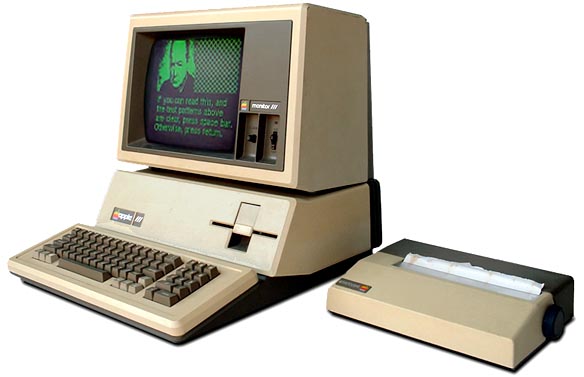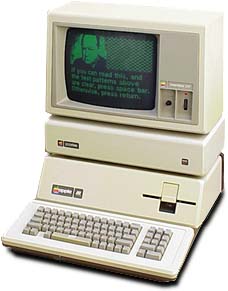|
|---|
History of the Apple Computer Corporation |
- 1973: Stephen Wozniak joins HP.
- 1976: Wozniak proposes that HP create a personal computer. He is rejected.
- 1976: March - Steve Wozniak and Steve Jobs finish work on a computer circuit board, that they call
the Apple I computer.
- 1976: April - Steve Jobs and Steve Wozniak form the Apple Computer Company, on April Fool's Day.
- 1976: July - The Apple I computer board is sold in kit form, and delivered to stores by Steve Jobs
and Steve Wozniak. Price: US$666.66.
- 1976: August - Steve Wozniak begins work on the Apple II.
- 1976: October - Wozniak remains at HP, but is soon convinced that he should leave and join Apple Computer.
- 1976: December - Steve Wozniak and Randy Wigginton demonstrate the first prototype Apple II at a
Homebrew Computer Club meeting.
- 1977: March - Apple Computer moves from Jobs' garage to an office in Cupertino.
- 1977: April - Apple Computer delivers its first Apple II system, for $1295.
- 1977: May - 10 months after its introduction, 175 Apple I kits have sold.
- 1978: Apple Computer begins work on an enhanced Apple II with custom chips, code-named Annie.
- 1978: Apple Computer begins work on a supercomputer with a bit-sliced architecture, code-named Lisa.
- 1979: June - Apple Computer introduces the Apple II Plus, with 48KB memory, for US$1195.
- 1979: September - Apple Computer sells 35,000 Apple II computers for the fiscal year.
- 1979: October - 2.5 years after the introduction of the Apple II, 50,000 units have been sold.
- 1979: Apple Computer begins work on "Sara", the code name for what will be the Apple III.
- 1980: May - Apple Computer introduces the Apple III. Price ranges from US$4500 to US$8000.
- 1980: September - Apple Computer sells over 78,000 Apple II computers during the fiscal year.
- 1980: Apple Computer ships the first Apple III units in limited quantity.
- 1980: Apple Computer begins project "Diana", which would become the Apple IIe.
- 1981: September - Apple Computer introduces its first hard drive, the 5MB ProFile, for US$3499.
- 1981: Apple Computer officially reintroduces the Apple III, with improved software and a hard disk.
- 1982: Sales of Apple II Plus to date: 45,000.
- 1982: Sales of all Apple II systems to date: 750,000.
- 1982: Apple Computer becomes the first personal computer company to reach US$1 billion in annual sales.
- 1982: Franklin Computer Corp. unveils the Franklin Ace 1000,
the first legal (at the time) Apple II clone.
- 1983: January - Apple Computer officially unveils the Lisa computer. Its initial price is US$10,000.
During its lifetime, 100,000 units are produced.
- 1983: January - Apple Computer introduces the Apple IIe for US$1400.
- 1983: June - The one millionth Apple II is made.
- 1983: June - Apple Computer begins shipping the Lisa.
- 1983: June - Video Technology introduces the Laser 3000, an Apple II workalike microcomputer.
- 1983: June - Unitronics shows the Sonic, an Apple II work-a-like microcomputer.
- 1983: July - Apple Computer officially begins marketing the Lisa computer.
- 1983: December - Apple Computer introduces the redesigned Apple III as the Apple III Plus, for US$3000.
- 1983: December - Apple unveils the new Macintosh to the press.
- 1983: Franklin shows an operating Franklin Ace 1200 Apple II compatible for US$2200.
- 1984: January - Apple releases a new version of the Lisa computer, the Lisa 2. It uses all new software,
as well as the Macintosh operating system.
- 1984: January - Apple Computer's Steve Jobs introduces the Apple Macintosh.
- 1984: April - Apple Computer unveils the
Apple IIc, priced at US$1300.
- 1984: April - Apple Computer retires the Apple III and Apple III plus, with only 65,000 units sold in total (90,000 made).
- 1984: May - Apple Computer announces that 70,000 Macintosh computers have been shipped in the first 100 days since
its announcement.
- 1984: September - Apple Computer introduces the Macintosh 512K for US$3200.
- 1984: November - The 2 millionth Apple II computer is sold.
- 1984: Apple sells the 250,000th Macintosh system.
- 1985: January - Apple Computer officially renames the Lisa the Macintosh XL.
- 1985: March - Apple Computer introduces the Apple Enhanced IIe.
- 1985: April - The Macintosh XL (formerly called Lisa) is dropped from Apple Computer's product line.
- 1986: January - Apple Computer introduces the Macintosh Plus. Price is US$2600.
- 1986: April - Apple Computer discontinues the original Macintosh and the Macintosh 512K.
- 1986: April - Apple Computer introduces the Macintosh 512K Enhanced, for US$2000.
- 1986: July - Apple Computer discontinues the Macintosh XL.
- 1986: September - Apple Computer introduces the Apple IIGS, with the Apple 3.5 drive, for US$1000.
- 1987: January - Apple Computer introduces the Apple Platinum IIe.
- 1987: March - Apple Computer introduces the open architecture Macintosh II, US$3900.
- 1987: March - Apple Computer makes its 1 millionth Macintosh personal computer.
- 1987: March - Apple Computer introduces the expandable Macintosh SE for US$2900.
- 1987: March - Apple Computer discontinues the Macintosh 512K Enhanced.
- 1987: Apple Computer begins shipping the Macintosh II.
- 1988: September - Apple Computer introduces the Apple IIc Plus for US$1100.
- 1988: September - Apple Computer introduces the Macintosh IIx computer, base price is US$7770.
- 1989: January - Apple Computer introduces the Macintosh SE/30, US$6500.
- 1989: September - Apple Computer announces the Macintosh Portable,
for US$6500.
- 1989: September - Apple Computer announces the Macintosh IIci, for about US$8700.
Source:
Chronology of Events in the History of Microcomputers
| |
|---|
|


 Since 1977, Apple had been making millions of dollars on their Apple II line of computers.
They sold hundreds of thousands of them, and it was the primary money maker for the company.
Since 1977, Apple had been making millions of dollars on their Apple II line of computers.
They sold hundreds of thousands of them, and it was the primary money maker for the company.

